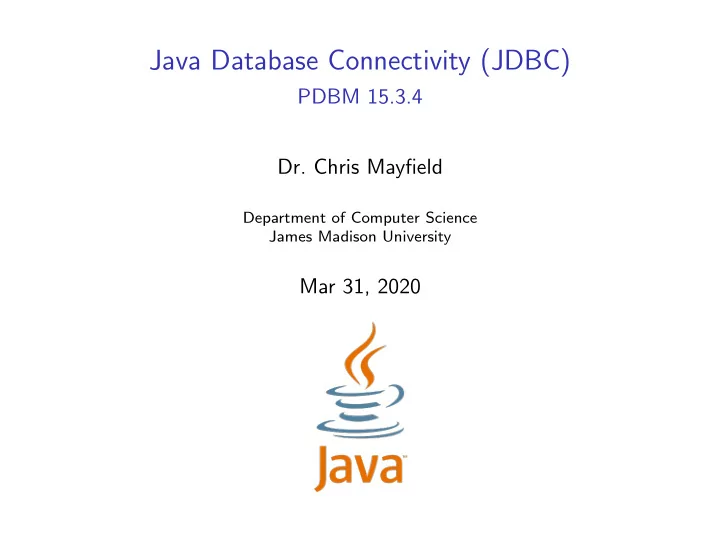

Java Database Connectivity (JDBC) PDBM 15.3.4 Dr. Chris Mayfield Department of Computer Science James Madison University Mar 31, 2020
Introduction to JDBC JDBC = Java Database Connectivity 1. Connect to the database → java.sql.Connection 2. Send queries and updates → java.sql.Statement 3. Retrieve/process results → java.sql.ResultSet import java.sql.* PostgreSQL’s JDBC driver ◮ Download jar file from https://jdbc.postgresql.org/ ◮ See https://jdbc.postgresql.org/documentation/head/ Mar 31, 2020 Java Database Connectivity (JDBC) 2 of 8
Load the driver Initialization during application startup: Class.forName("org.postgresql.Driver"); ClassNotFoundException if driver not available ◮ Make sure the jar is in your class path Don’t need to do this before every connection! ◮ Usually part of application startup code Mar 31, 2020 Java Database Connectivity (JDBC) 3 of 8
Connect to the DB Connection db = DriverManager . getConnection ( url , username , password ); URL format is specific to the DBMS ◮ jdbc:postgresql:database ◮ jdbc:postgresql://host/database ◮ jdbc:postgresql://host:port/database Internally, uses same library as psql and pgAdmin Mar 31, 2020 Java Database Connectivity (JDBC) 4 of 8
Execute a statement String sql = "SELECT * FROM mytab WHERE foo = 500"; Statement st = db. createStatement (); ResultSet rs = st.executeQuery (sql); while (rs.next ()) { System.out.print("Column 1 returned "); System.out.println(rs.getString (1)); } rs.close (); st.close (); ResultSet can also do getInt( i ), getFloat( i ), . . . ◮ Note that column indexes start at 1! For non-queries, use rs.executeUpdate(sql) Mar 31, 2020 Java Database Connectivity (JDBC) 5 of 8
Better yet, a prepared statement int foovalue = 500; String sql = "SELECT * FROM mytab WHERE foo = ?"; PreparedStatement st = db. prepareStatement (sql); st.setInt (1, foovalue ); ResultSet rs = st.executeQuery (); while (rs.next ()) { System.out.print("Column 1 returned "); System.out.println(rs.getString (1)); } rs.close (); st.close (); The ‘?’ syntax provides additional type safety ◮ String arguments are automatically escaped ◮ Helps prevent SQL injection attacks https://xkcd.com/327/ Mar 31, 2020 Java Database Connectivity (JDBC) 6 of 8
Details about statements Use a single Statement instance as many times as you want ◮ However, only one ResultSet can exist per Statement or PreparedStatement at a given time ◮ If you need to run a query while processing a ResultSet , simply create and use another Statement If you are using threads, and several are using the database, you must use a separate Statement for each thread. When you are done using the Statement or PreparedStatement you should close it. Mar 31, 2020 Java Database Connectivity (JDBC) 7 of 8
Details about result sets Before reading any values, you must call next() ◮ Returns true if there is a result ◮ More importantly, prepares the row for processing You should close a ResultSet once you have finished ◮ If you make another query with the RS’s Statement . . . ◮ . . . then the ResultSet instance is closed automatically Now you try it! ◮ Create a Java application that outputs school divisions Mar 31, 2020 Java Database Connectivity (JDBC) 8 of 8
Recommend
More recommend